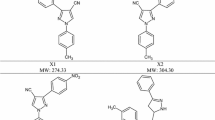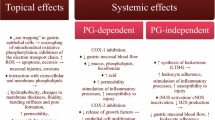Abstract
Ethyl 4-biphenylyl acetate (EBA) is a prodrug of the antiinflammatory 4-biphenylyl acetic acid (BPAA). The inclusion complexes of EBA with β-cyclodextrin (β-CyD), heptakis(2,6-di-O-methyl)-β-cyclodextrin (DM-β-CyD), and 2-hydroxypropyl-β-cyclodextrin (HP-β-CyD) at a molar ratio of 1:2 (EBA:cyclodextrin) were prepared and used to make hydrophilic antiinflammatory ointments. The in vitro release of EBA from the ointments was enhanced by complexation in the order of β-CyD < DM-β-CyD ≤ HP-β-CyD. The improvement correlated with the improved solubility and not with the decreased diffusibility observed to occur upon the complexation of EBA. In vivo the complexation with cyclodextrin derivatives increased both the release of EBA from the vehicle and its conversion in the underlying tissue to BPAA, but the total of EBA and BPAA in the tissue was decreased. In vitro studies confirmed that the effects of cyclodextrin derivatives on the conversion were exerted indirectly. The combination of the enhanced release and of the enhanced prodrug hydrolysis by esterases in the site where the antiinflammatory action is required resulted in increased therapeutic effects. In the model of carrageenan-induced acute edema in rat paw, the complexation improved the therapeutic effects over those of EBA alone in the order of β-CyD < DM-β-CyD < HP-β-CyD. HP-β-CyD may be a particularly useful cyclodextrin derivative since it improves the topical availability and does not irritate tissues.
Similar content being viewed by others
REFERENCES
S. Y. Chan and A. L. W. Po. Int. J. Pharm. 55:1–16 (1989).
D. A. W. Bucks. Pharm. Res. 1:148–153 (1984).
J. Pitha. J. Incl. Phenom. 2:477–485 (1984).
J. Szejtli. In V. F. Smolen and L. A. Ball (eds.), Controlled Drug Bioavailability, John Wiley & Sons, New York, 1985, pp. 365–420.
K. Uekama and M. Otagiri. CRC Crit. Rev. Ther. Drug Carrier Syst. 3:1–40 (1987).
W. Saenger. In J. L. Atwood, J. E. D. Davies, and D. D. MacNicol (eds.), Inclusion Compounds, Vol. 2, Academic Press, London, 1984, pp. 231–259.
J. Szejtli. J. Incl. Phenom. 1:135–150 (1983).
J. Pitha, T. Irie, P. B. Sklar, and J. S. Nye. Life Sci. 43:493–502 (1988).
K. Uekama and T. Irie. In D. Duchêne (ed.), Cyclodextrins and Their Industrial Uses, Editions de Santé, Paris, 1987, pp. 393–439.
A. Yoshida, H., Arima, K. Uekema, and J. Pitha. Int. J. Pharm. 46:217–222 (1988).
H. Arima, H. Adachi, T. Irie, and K. Uekama. Drug Invest. (in press) (1990).
J. Pitha, J. Milecki, H. Fales, L. Pannell, and K. Uekama. Int. J. Pharm. 29:73–82 (1986).
H. Arima,, T. Irie, and K. Uekama. Int. J. Pharm. 57:107–115 (1989).
K. Uekama, K. Masaki, K. Arimori, T. Irie, and F. Hirayama. Yakugaku Zasshi 107:449–456 (1987).
T. Higuchi. J. Pharm. Sci. 50:874–875 (1961).
W. I. Higuchi. J. Pharm. Sci. 51:802–804 (1962).
F. S. Chiccarelli, H. J. Eisner, and G. E. V. Lear. Arzneim.-Forsch./Drug Res. 30:707–715 (1980).
K. Yamaoka, T. Nakagawa, and T. Uno. J. Pharmacok. Biopharm. 6:547–558 (1978).
C. A. Winter, E. A. Risley, and G. W. Nuss. Proc. Soc. Exp. Biol. Med. 111:544–547 (1962).
H. Okamoto, H. Komatsu, M. Hashida, and H. Sezaki. Int. J. Pharm. 30:35–45 (1986).
A. Gerlóczy, S. Antal, and J. Szejtli. In O. Huber and J. Szejtli (eds.), Proceedings of the 4th International Symposium on Cyclodextrins, Kluwer Academic, Dordrecht, 1988, pp. 415–420.
T. Hoshino, K. Ishida, T. Irie, K. Uekama, and T. Ono. Arch. Dermatol. Res. 281:60–65 (1989).
K. Ishida, T. Hoshino, T. Irie, and K. Uekama. Xenobio. Metabol. Dispos. 3:377–386 (1988).
R. J. Martin, S. P. Denyer, and J. Hadgraft. Int. J. Pharm. 39:23–32 (1987).
J. Hadgraft. In H. Bundgaard (ed.), Design of Prodrugs, Elsevier, Amsterdam, 1985, pp. 271–289.
D. B. Guzek, A. H. Kennedy, S. C. McNeill, E. Wakshull, and R. O. Potts. Pharm. Res. 6:33–39 (1989).
R. O. Potts, S. C. McNeill, C. R. Desbonnet, and E. Wakshull. Pharm. Res. 6:119–124 (1989).
Y. Ozawa, I. Koyama, S. Murayama, and T. Nadai. Chem. Pharm. Bull. 33:5113–5118 (1985).
Y. Mizushima. Drug Deliv. Syst. 2:3–12 (1987).
M. E. Brewster, J. W. Simpkins, M. S. Hora, W. C. Stern, and N. Bodor. J. Parent. Sci. Tech. 43, 231–240 (1989).
Author information
Authors and Affiliations
Rights and permissions
About this article
Cite this article
Arima, H., Adachi, H., Irie, T. et al. Enhancement of the Antiinflammatory Effect of Ethyl 4-Biphenylyl Acetate in Ointment by β-Cyclodextrin Derivatives: Increased Absorption and Localized Activation of the Prodrug in Rats. Pharm Res 7, 1152–1156 (1990). https://doi.org/10.1023/A:1015932325998
Issue Date:
DOI: https://doi.org/10.1023/A:1015932325998




